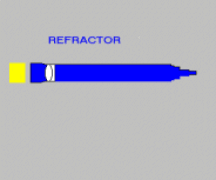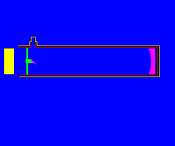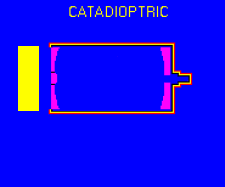![]()
WHAT YOU NEED
After you become more and more familiar with the night sky, you'll
have a certain feeling of wanting to see more than what you have always seen. Well,
you can check your saving account and see if you have enough money to buy a
telescope :-)
But, before you buy a telescope it's really a good idea to buy a pair of
binocular first, if you don't already have one. With binoculars you can see
more stars than you can with naked eyes, and binoculars are extremely portable.
You can carry it anywhere you go, it's ready for action in seconds. Binoculars
are used by many experienced amateurs. Binoculars will give you wide field of view,
and the fact that you can use both of your eyes when viewing the sky, will give
you a pleasant view of the sky.
If you already have binoculars but only take
them to the beach, try to take it out one night and aim it to the sky (don't aim
it to the beautiful girl's window across the street!) you'll see the more stars
than with naked eyes.
Now, what telescope should I buy?
That's a tough question. I'm not going
to tell you what telescope you should buy, that depends on many factors. Below,
you can read some basic information that might help you choose the right
telescope, but for much more comprehensive and detailed information on how to
pick the right telescope you have to read Donald's essays My First
Telescope. You can follow the link at the bottom of this page to go to the
Essays section.
TYPES OF TELESCOPE
If you look at the ads in astronomy magazines you'll see a different kind of telescopes made by various manufacturers. But they come to three main types of telescopes: refractor, Newtonian reflector and catadioptric (compound) telescope.
 This is the "classic"
telescope that almost everyone knows or, at least, have seen. Refractor uses lens as
objective. This lens, located at the top end of the tube, collects and refracts
light and then the light travels to focus at the bottom of the tube. In the
animation here the light (yellow) enters the tube from the left, refracted and
reach the focus at the end of the tube on the right.
This is the "classic"
telescope that almost everyone knows or, at least, have seen. Refractor uses lens as
objective. This lens, located at the top end of the tube, collects and refracts
light and then the light travels to focus at the bottom of the tube. In the
animation here the light (yellow) enters the tube from the left, refracted and
reach the focus at the end of the tube on the right.
Refractors are more
expensive than other types of telescope. For instance, one manufacturer's
price for its 4" apochromatic (free of color) refractor costs more than its
16" reflector.
Why? Some people say that it is due to the difficulty in
making a high quality refractor and the high price of the glass for the
objective.
If you plan to buy a refractor, do not buy a "department store"
telescope. You'll know this one when you see it. This kind of refractor
usually sold in department store and has "500 x magnification" label on its
box. You'd better use your money to buy binoculars instead.
 The most popular
reflector is Newtonian reflector. It's named Newtonian because it was Isaac
Newton who invented it.
The most popular
reflector is Newtonian reflector. It's named Newtonian because it was Isaac
Newton who invented it.
Newtonian reflector uses mirrors instead of lens.
One concave mirror or called the primary mirror at the bottom of the tube (in
the animation here on right) reflected the light entering the tube from the
left, to a second flat mirror (secondary mirror) located near the top of the
tube which in return directs the light to focus at the side of the
tube.
This is the type of telescope that commonly built by Amateur
Telescope Makers.
 This one is like a
combination of the first two types. It uses a correcting lens at the front of
the tube and two mirrors. The light enters the tube through the correcting
plate to the primary mirror (concave), then reflected to a second covex mirror
attached to the correcting lens which then directs the light to focus at the
bottom of the tube.
This one is like a
combination of the first two types. It uses a correcting lens at the front of
the tube and two mirrors. The light enters the tube through the correcting
plate to the primary mirror (concave), then reflected to a second covex mirror
attached to the correcting lens which then directs the light to focus at the
bottom of the tube.
Two popular types of catadioptric are Schmidt-Cassegrain and Maksutov-Cassegrain.
Aside from the types of telescope, there are some other things that you need to know and consider before you buy your first telescope.
If you're thinking about doing astrophotography in the future, it will be
better if you buy an equatorial mounted telescope.
But if you want to do
astrophotography and you're willing to learn new skills, like woodworking, buy
an alt-azimuth mounted telescope (Dobsonian type) and motorized it later. It
means, you build your own motor drive. Although you can buy a motor drive from a manufacturer, building it yourself will be
cheaper, and you can use the money you saved to buy a high quality eyepieces.
Aperture is the diameter of a telescope's objective. So if you read
something like 4" telescope, that means the telescope's objective has a
diameter of 4".
The aperture of a telescope relates to its light gathering
capabilty. Compare two telescope of the same optical quality. The first one
has a 4" objective and the second has a 6" objective. The telescope with 6"
aperture will show you more stars than the one with 4" objective. It's simply
because a 6" objective collects more light than a 4" objective so it shows
more stars. And an 8" objective collects more light than a 6", so reveals more
stars than 6", and so on.
The rule of thumb is the larger the aperture, the more
light it collects, and the more light it collects, the fainter the stars that
can be seen through it, or the more you can see.
"Okay, I got it. So, does it mean I should buy the largest telescope I can
get?"
Well, the answer is not exactly. There is another thing you have to
consider before you go out and buy the biggest telescope your money can buy.
Portability and stability has to be considered in purchasing a telescope.
In my opinion, these are the most important things in a telescope after the
quality of its optics.
Let's imagine this.
You want to buy a telescope. And
since money is not an issue, you want to buy a state-of-the-art computer
controlled telescope. The kind of telescope that will take you to any object
you want just by dialing the object's coordinate.
Since you've been told
about light gathering power and about how great the view is seen through a
large aperture telescope, you decided to buy a 12.5" SCT. A big (and heavy of
course) telescope with a heavy duty tripod and sturdy mount which will give
you a pleasant view of the universe.
The telescope finally arrive. You familiarize yourself with the gadgets and
start the observing session.
Now you're ready and want to observe from your
backyard. Carrying the scope in one piece will be too hard, it's heavy (it
weights close to 40 kg, maybe more). So you took it apart. The Tube, the wedge
and the tripod.
First you carry the tripod to the backyard. Set it up and
go back inside to take the wedge and place it on the tripod. And then you go
back inside to take the tube. And place the tube on the wedge. That's three
round trips from and to your backyard.
After the observing session, again
you disassemble the scope, and repeat the same ritual of walking from and to
the backyard.
For some time, this ritual is not a problem for you. And I sincerely hope
it will never be a problem for you. But after some time, chances are it will.
Don't be surprised if you find yourself spending less and less time under the
starry sky.
Don't be surprised if you come up with an excuse like "I'm too
tired tonight I'll observe tomorrow night." Don't say it will never happen to
you, especially if you're a beginner like me.
I know it, it happened to
me.
I do not mean to and I do not want to discourage you. I just want to tell
you what might happen. If it doesn't happen to you, that's great! I'm happy
for you.
As I said earlier, portability and stability are really important. You need
a portable scope so you can observe whenever you want. You need a portable
scope because it will only take a short time to set it up. You need a portable
scope so you can carry it easily to wherever you want to go.
And yet, you need telescope on a stable mount so that you can observe
without being annoyed by the vibration. An unstable telescope mount will bring
you frustration instead of joy. So when you buy a telescope, get one that's portable and has a sturdy
mount. If you have a portable scope you'll take it out often cause it's easy,
and doesn't take too much effort to carry it and set it up. And if it's stable, you
won't be frustrated by the image, you'll have a pinpoint stars images in the
eyepiece.
Took the scope apart, made two round
trips from and to the backyard, set it up, observe. After I'm finished I
took
it apart again, another two round trips, set up the scope again in the house
and cover it.
That's the ritual I went through every time I
observed. And then I found I observed less and less, and finally for 6 months I left
the scope untouched! And my telescope is not that big, it's only an 8" SCT.
Every time you move the scope or touch it,
the stars image will also move wildly. So you don't see fix dots of light, but
you'll see dots of light jumping around, like what you see in an oscillator.
It will be frustrating and you might loose your interest in astronomy.
![]()
© 2005 [email protected]